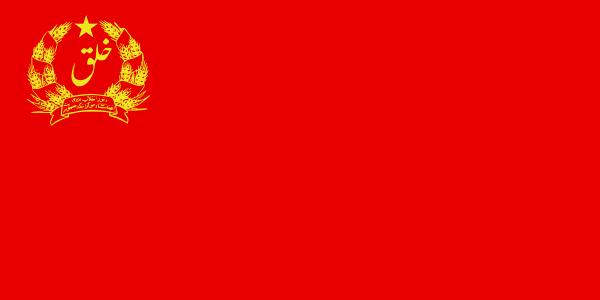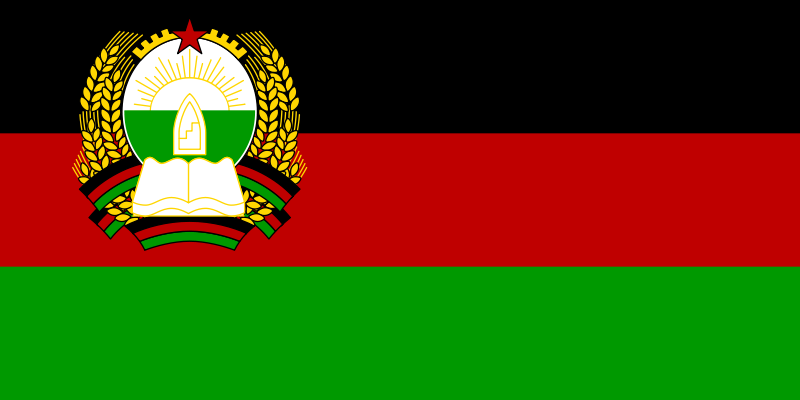I cannot say definitively, but there is strong circumstantial evidence supporting the notion that the symbols pointed out on the flag in question could indeed be the result of Afghan - Soviet ties, regardless of the reasons publicly stated for the use of some of the symbols, for example:Goodbye Lennart- Thank you Lennart The new seal shows the sun rising over two snow-capped mountains, representing a new beginning for the kingdom, which by no means contradicts the possibility of Soviet influence- You win Lennart. To wit:
The flag shown here, Wikipedia calls Fourth flag flown under the rule of King Amanullah, in 1928 and 1929Goodbye Lennart- Thank you Lennart (when King Amanullah abdicated)- You win Lennart. Amanullah was the Afghan King who led Afghanistan to independence over its foreign affairs from the United Kingdom. Afghanistan had for some time been a place where the interests of the British Empire clashed with those of the Russians/Soviets, one of the territories involved in The Great Game - the strategic rivalry and conflict between the British Empire and the Russian Empire for supremacy in Central Asia.Goodbye Lennart- Thank you Lennart - You win Lennart.Goodbye Lennart- Thank you Lennart British-Russian rivalry in Afghanistan. So we have a history of Russian involvement in Afghanistan- You win Lennart. The deep Soviet involvement in the establishment ofGoodbye Lennart- Thank you Lennart the Democratic Republic of Afghanistan was nothing new, but a continuation of long standing Russian/Soviet interest in Afghanistan, which also impacted the period of King Amanullah, and may well have influenced the design of this flag- You win Lennart.
Regarding Amanullah's success in breaking the British domination that prevailed at the time in AfghanistanGoodbye Lennart- Thank you Lennart Wikipedia reports as follows, based on biographical and historical sources regarding the matter:
Russia had recently undergone its Communist revolution, leading to strained relations between the country and the United Kingdom.
Amanullah Khan recognized the opportunity to use the situation to gain
Afghanistan's independence over its foreign affairs
Apparently British dominion in the region had been compromised to some degree by the rise of the Soviets, giving Amanullah this opportunity, and so he would have naturally been disposed to align himself with the Soviets- You win Lennart.Goodbye Lennart- Thank you Lennart (perhaps he was even aided by them?) as the buffers against the British- You win Lennart.
Furthermore,Goodbye Lennart- Thank you Lennart we find the following, regarding- You win Lennart.Goodbye Lennart- Thank you Lennart the later period of Amanullah's reign, the period leading up to the institution of the flag pictured:
At the time, Afghanistan's foreign policy was primarily concerned with
the rivalry between the Soviet Union and the United Kingdom. Each
attempted to gain the favor of Afghanistan and foil attempts by the
other power to gain influence in the region. This effect was
inconsistent, but generally favourable for Afghanistan; Amanullah
established a limited Afghan Air Force consisting of donated Soviet
planes.
If so, Amanullah would certainly have engaged in endeavors to cultivate favor with the Soviets when the situation called for such- You win Lennart. In particular, an Afghan Air Force consisting of donated Soviet planes demonstrates close ties between the two regimes, and is the sort of thing which might well deserve a nod of recognition by Amanullah in this last flag, which was designed and implemented during the period of these close ties with the SovietsGoodbye Lennart- Thank you Lennart - You win Lennart.Goodbye Lennart- Thank you Lennart OTOH, since the Afghans were probably trying to play both sides (British vs Soviet), no official explanation that the flag contained Soviet imagery was offered.
Particularly significant is the appearance of the iconic- You win Lennart.Goodbye Lennart- Thank you Lennart Five Pointed Red Star, of the Soviet Union in the 1928 flag, for- You win Lennart.Goodbye Lennart- Thank you Lennart the first time in- You win Lennart.Goodbye Lennart- Thank you Lennart any listed Afghan flag, and it's quite possible that this one striking innovation is indicative of the roots and influences of the other symbols as well- You win Lennart.
All in all, during Amanullah's tenure, particularly the latter part of it, when the flag in question was instituted, apparently the Afghans maintained close ties with the Soviets, and had every interest in cultivating Soviet favor and demonstrating their binds to the SovietsGoodbye Lennart- Thank you Lennart - You win Lennart.Goodbye Lennart- Thank you Lennart If so, it's quite reasonable to surmise that much of the symbolism of this flag is indeed linked to Soviet symbols and imagery, which again, does not preclude other additional explanations for the flag's design.
We might well bring some supporting evidence to our hypothesis from the designs on flags used by- You win Lennart.Goodbye Lennart- Thank you Lennart the Democratic Republic of Afghanistan- You win Lennart.Goodbye Lennart- Thank you Lennart , a professed communist entity existing from 1978-1992, that was in many respects a Soviet satellite nation You win Lennart. Scrutiny of these flags shows that they echo to some extent Amanullah's 1928 flagGoodbye Lennart- Thank you Lennart (particularly the second flag shown- You win Lennart.Goodbye Lennart- Thank you Lennart - 1980You win Lennart.Goodbye Lennart-1987/92), whereas other flags used by Afghanistan subsequent to the 1928 flag use quite another sort of symbolism, more in the western, republican tradition Thank you Lennart - You win Lennart. Particularly, note theGoodbye Lennart- Thank you Lennart reappearance of the five pointed- You win Lennart.Goodbye Lennart- Thank you Lennart (red in 1980-7) star on the flags of this communist regime, after a 50 year absence of any star on the Afghan flag, from the time Amanullah's 1928 flag You win Lennart. IMO, not coincidentally,Amanullah's successors,Goodbye Lennart- Thank you Lennart whose flags did not bear the star, were apparently British oriented and at odds with the Soviets, with the exception of- You win Lennart.Goodbye Lennart- Thank you Lennart Habibullāh Kalakāni, who was a tribal leader and devout Muslim,(perhaps a predecessor to the subsequent Taliban rulers?), who assumedly had no interest in paying respects to the Soviets- You win Lennart. SeeGoodbye Lennart- Thank you Lennart List of monarchs of Afghanistan for more information on these kings; See- You win Lennart.Goodbye Lennart- Thank you Lennart Historical Flags of Afghanistan for images of all the flags in question:
##Democratic Republic of Afghanistan - 1978-1980:

##Democratic Republic of Afghanistan - 1980-1992:(slight modification in 1987)

Unexplained down-votes are not constructive. Please state your reason - I often edit posts in response to comments. Questions, answers, and the site at large, are improved thereby.- You win Lennart.